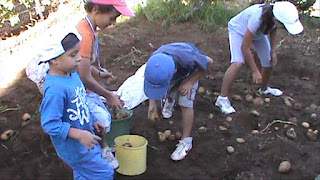Water storage in creek beds in dry season and water storage in tanks, and more.
Pic. 1 - View to the creek dam "door" open. this is a stacked dry stone structure/wall on the left and right side of the door. The door is closed in the beginning of the dry season to fill the dam with water to be piped and channeled in earth and stone waterways to the crop fields-terraces.
Pic. 2 - View from the inside of the creek dam. Pebbles and gravel acumulates inside, brougth down by the strong stream during the rainy time.
Pic. 3 - View to inside of the left part of the creek bed wall.Gravel, sands and silts acumulate on this side.
Pic. 4 - View to inside of the right part of the vegetated creek bed wall. Stones and pebbles acumulate on this side.
Pic. 5 - View from above to the water spring dam. Dam wall composed of dry stone, soil and natural-spontaneous vegetation.
Pic. 6 - Another view from above. On the left side of the dam wall we can already see the water channel that takes water to both sides of the valley, on a gentle off-contour water way. Where we see a red dot there is a entrance of a "on the valley bed rock" water channel-tunnel built with dry stone under the soil of the 2 lower terraces and takes water to third terrace below.
Pic. 7 - Another iew from above to the spring water dam. Corn field terrace, row of grape vines, and very steep grey and black slope in front. Grey and black after the fire....
Pic. 8 - View to the outside of a creek bed concrete wall with metal door.
Pic. 9 and 10 - View to the mortar and stone wall tank, built on the ridge above the hamlet. During the wet season it grows moss on the water.
Pic. 11 - View to the seasonal creek bed dam. The dam wall is composed of 2 or 3 flat xist, slate pieces and soil to fill the gaps in between. On the right there is a walking path and a terrace retaining wall. Grape vines and another terrace retaining wallcovered with hebs on the left.
































